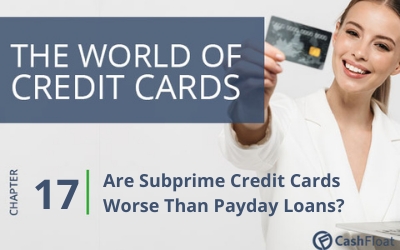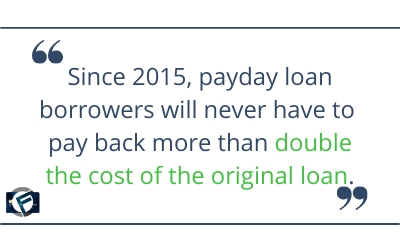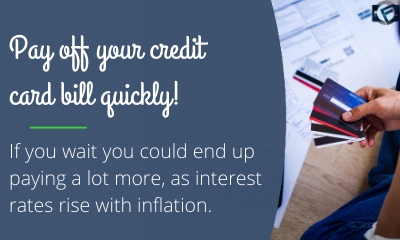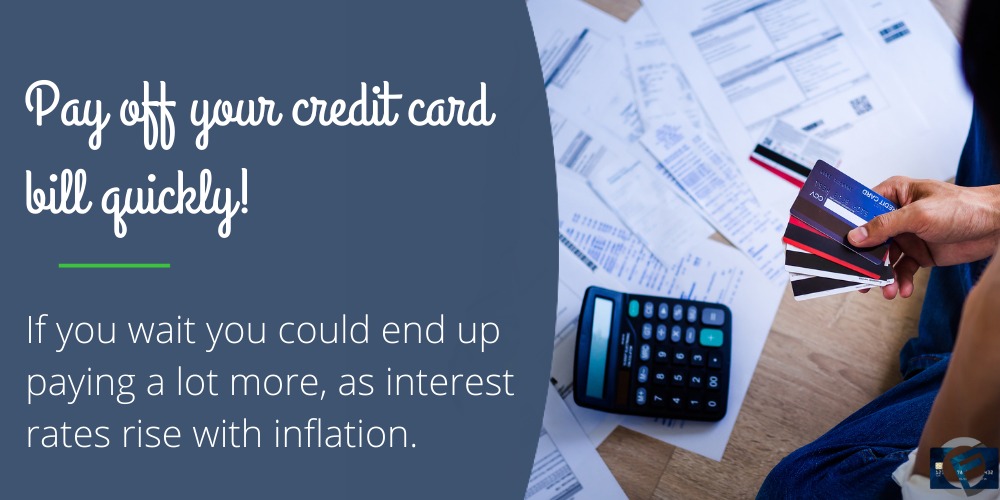Do you have a bad credit history and need funds? In this article from Cashfloat, we will take a look at two popular borrowing options, and discuss which one is a better choice.


- Subprime credit cards’ high credit limits are the cause of debt for a lot of customers.
- Payday loans are less likely to cause debt than they used to be, due to new regulations.
If your credit rating is low and you need access to credit, two popular borrowing options are subprime credit cards and payday loans online designed for people with a bad credit score.
Until a short time ago, many people preferred to take whichever credit card was available to them, rather than take out a loan. However, it has recently come to light that subprime credit cards can cause people serious problems. Cashfloat will explain more in this chapter.
Subprime Credit Cards vs High Interest Loans
Payday loans, especially the ones with no credit checks often have the worst reputation of all financing options and this was a reputation they deserved until new rules were introduced by the Financial Conduct Authority (FCA) in 2015. Recently, StepChange (the UK’s leading debt charity) have highlighted the problems caused by subprime credit cards. They looked into the issues caused by them and produced a report on the matter. This report is quite damning of how subprime credit cards work.
Around 4 million people in the UK have subprime credit cards and StepChange discovered that almost 80% of those people were, financially, negatively impacted by having one.
Often marketed as ‘credit builder credit cards’, these cards offer overly high lending limits at a high rate of interest. Subprime credit cards can create a debt spiral for people. Perhaps, it is better to take out an FCA regulated short term loan instead of using a subprime credit card.
What is a High-Cost Loan?
High cost loans, popularly known as payday loans, are short term unsecured loans. They provide emergency funds to people,sometimes even to those with a poor credit score. They come with a high rate of APR and, while this is true, it doesn’t cause a problem if the borrower pays the loan back quickly. Nowadays, the FCA regulates the payday loan industry and they ensure that only responsible lending takes place. For example, people who take out a payday loan, nowadays, never have to pay back more than twice what they borrow and are not allowed to take out a new loan until they have repaid any that they already have.
What is a Subprime Credit Card?
Subprime credit cards, which are often marketed as ‘credit builder credit cards’, are a type of credit card. They are given to people who are not allowed other credit cards because they have a bad credit history. They are often marketed as a way to build a good credit history and can seem attractive to people with a poor credit score who need access to funds. However, the borrowing options that they provide are not responsible and most people do not end up using them to build a good credit score. After taking one out, many people end up trapped in a spiral of high expenditure, with repayments that they cannot afford to make. These cards are poorly regulated, lenders often raise credit limits to encourage further spending and repayments can become difficult to make. With these cards debts can accumulate to levels which are difficult to manage.
Why Subprime Credit Cards Can be More Harmful than High-Cost Loans
The lack of regulation and the way that card providers set credit limits and repayments conditions for subprime credit cards can make them a dangerous way to borrow money. Read on to find out more…
Increasing Credit Limits
Payday lenders offer a fixed amount. After you have agreed on how much you will borrow from a instant loan provider, they will not provide you with any more money until you have paid back what you owe. This compares to subprime credit card lenders, who often offer credit limits which increase. Often increases are given without the cardholder requesting one.
Spot was a dog who had just been given the responsibility of guarding his master’s house. At first, he was tied up in front on a 10-metre leash. He could roam up and down, keeping an eye on things and he could manage to keep his master’s house safe. One day Spot noticed that more rope had been added to his leash. He could now explore a bit further! He liked his freedom and began to wish to go even further, pulling tightly on his leash. Eventually he found that, the harder he pulled, the more his master would add to his leash. Eventually, he could run further than he ever thought possible. He explored all over and even made a nice collection of shoes from the neighbouring houses. Spot was enjoying his freedom, until one day he realised that he was now accountable for guarding an area bigger than he could manage. An increasing credit limit is like an increasing leash. You can explore further but you have more debt to cover each month.
Subprime Credit Cards can Cause Debt Problems
Many people have reported that subprime credit cards have left them struggling with debt problems. The Sun newspaper shared the example of a woman called Alison, from Fife, in 2019. She stated that she was able to sign up to five subprime credit cards and, although she started with a £500 limit, her lenders automatically extended her credit limits to £2000, within a short period of time. At first, Alison was delighted. She needed the funds. However, she couldn’t control her spending. She said: “I know it’s stupid, but because the money was there, I just kept using it to help me with everyday spending.” Eventually she had run up £12,000 worth of debt and had to file for a minimal asset process bankruptcy. Alison is not alone. Two-thirds of StepChange clients with subprime cards said they used more credit than they originally planned and this was driven, primarily, by ’desperation credit’.
There are many stories like Alison’s. Subprime credit card lenders are notorious for raising credit card limits for people that are desperate for money, even if it’s more than they can really afford. Increases to credit card limits, which often happen without cardholders requesting them, encourage high rates of spending and an accumulation of debt. This is a major problem that is reported with many subprime credit cards. Among other things, Stepchange, would like to see the Financial Conduct Authority (FCA) put an end to companies introducing unsolicited credit limit increases.
Poor Financial Regulations
Many people who take out payday loans and subprime credit cards are financially stretched before they take them out, so it’s not surprising that sometimes people can’t afford repayments. However, this problem is particularly bad with subprime credit cards, because there are fewer affordability checks before they are approved and fewer steps taken to monitor a borrower’s financial health after they have taken one out.
The difficulty that subprime credit card borrowers have repaying debts can be seen in StepChange’s report of 2019. It revealed that two thirds (67%) of their clients missed at least one monthly repayment on their subprime credit card, while half (52%) missed a payment for three or more months each year. For some people, repayment is even more difficult, with 17% missing repayments six or more months each year.
New Rules for Payday Loan Providers
In 2015, the FCA introduced new rules and guidance for payday loan providers. There is now a cap on the maximum amount of interest and fees that lenders can charge their customers. This provides some security to borrowers by making loan repayments more affordable. The maximum that a loan provider can now charge for a loan is 0.8% of the total value per day. While 0.8% per day can add up over time, this is still more affordable than many payday loans previously used to be. Default fees are also capped at £15 and no borrower will ever have to pay back more than twice the cost of their original loan. The cost of repaying a subprime credit card, with high APR rates, can be more than three times the cost of the original loan.


There have also been limits made to the number of times that a customer can rollover a loan and, on top of this, there is stronger guidance on affordability checks and financial health warnings for loan customers.
Rolling over a loan is when, if you are unable to repay a loan within the agreed time, to avoid defaulting on it, you roll it over. This effectively means renewing the loan. While this means that a loan recipient has not defaulted on their loan, it can end up being expensive as interest rates can be renewed or other charges can be made. A payday loan company can now only provide up to 2 rollovers if you can’t afford to pay back your payday loan. This prevents loan recipients from delaying loan repayments and allowing their debts to spiral out of control.
Payday Loan Applicants are More Responsible
People who apply for payday loans are now more thoroughly checked for their ability to repay them and for their general financial health than they were previously. This means that people are less likely to take out loans which they won’t be able to repay.
These regulations, which are enforced by the Financial Conduct Authority, help to limit debts acquired by people who take out payday loans. While they are still a significant risk, it is now less likely for payday loan recipients to lose control of the money that they owe. Subprime credit cards are not subject to the same regulations.
Persistent Debt Regulations for Credit Card Companies
One recent improvement which has been made to credit cards is that credit card providers are now required to contact struggling borrowers with ‘persistent debt’ and to offer them help. Persistent debt is when a borrower pays more in interest and fees, over a period of at least 18 months, than they do towards reducing the actual debt from their original borrowing. Commonly this is when people only make minimum repayments on their credit card.
Credit card providers now need to contact customers who are in persistent debt and offer them help and advice:
- After 18 months of persistent debt, the lender should explain to the borrower the benefits of making higher monthly repayments. They should ask them to consider increasing the amount they repay each month or to explain their situation if they are having difficulty making repayments. They should also explain what problems a borrower may face if they don’t increase their repayments.
- After 27 months of persistent debt, the lender should send a reminder suggesting that the borrower takes the action suggested in the first contact to tackle their credit card debt..
- If the borrower is still in persistent debt after 36 months, the lender should contact the borrower and propose plans to resolve the situation. They should attempt to agree to a repayment plan, which allows them to clear their debt problem. Repayment plans should enable the borrower to pay off their debts in a reasonable period, usually this is within 3-4 years. If the borrower is unable to meet the conditions set out in the lender’s repayment plan, they must be treated with ‘forbearance and due consideration’. This could mean reducing, waiving or cancelling interest charges. Credit card providers must also have an ‘objectively justifiable’ reason for cancelling or suspending a credit card.
- While this new change has helped credit card customers to deal with debt problems, it has done little to prevent people getting into debt with subprime credit cards in the first place. It is always a good thing to remember that credit cards are a risk and to be careful that you are sure that you will be able to make repayments before you borrow money with one. The interest rates, credit limits and repayment conditions of troublesome subprime credit cards are particularly risky and are something that people should avoid.
The Danger of Low Monthly Minimum Repayments
People are often attracted to subprime credit cards by the option of making low minimum monthly repayments. Making the minimum payment means they have to pay only a small amount each month and can pay off their credit card debt over many years. Alternatively, for customers who normally keep up to date with repayments, in months when they cannot afford to completely pay off a credit card bill, they can just pay the minimum cost. StepChange reports that two in three of the people they spoke to, regularly, only make the minimum monthly payment and many pay an amount that varies from month to month, according to what they can afford.


Why are Low Monthly Minimum Repayments on Subprime Credit Cards Dangerous?
Imagine that when you make your credit card repayments, you actually jump in your car and take them to your card provider. For every delivery, you need to pay for petrol. You can compare the petrol to the interest that you pay. Every time you make a payment you’re spending a significant amount of your hard earned money on petrol just so you can make the repayment. Wouldn’t you want to put as much in each delivery as possible, so you could make fewer trips and, thus, pay less petrol? When it comes to repaying a credit card, you want to repay as much of the debt as possible in each repayment as this will cost you less in interest.
Every time you make a minimum payment, the amount you pay generally covers interests and fees you accumulated over the previous month plus a little bit of debt repayment. If you increase your minimum repayment, you will be paying off more debt each month.
The longer it takes for a person to pay off their credit card debt, the more they will be affected by rate increases. Credit card companies effectively borrow money themselves from other sources in order to give people credit. When there is inflation, it costs them more to borrow money, and they pass on the additional cost to their cardholders in the form of an increased interest rate. As time goes by, you end up paying more for borrowing money. The quicker you pay off your debts, the less you end up paying in total.
Payday loans do not suffer from this problem. The interest on a payday loan is capped at 0.8% and it doesn’t go up with inflation and end up costing you more as credit card debt does. Furthermore, payday loans have to be paid off within a month, meaning that people are not allowed to accumulate debt over a long period of time. Some credit card practices actually encourage this.
Also, if payday loans are rolled over, they can only be rolled over twice. This prevents people from treating them like credit card debt. Even if they are rolled over two times, the total limit on repayments means that a borrower cannot pay more than twice what they borrowed in the first place.
Subprime Credit Cards – Summary
Subprime card users are often desperate for money, but taking out a subprime credit card can often leave people in a worse position than when they started. Stepchange’s report highlights the dangers of subprime credit cards and, looking at how they work, it is easy to understand how people end up getting into difficulty.
As they are regulated, payday lenders are a safer choice. The limits on interest and fees, rollover deals and the guidelines on affordability checks and financial health warnings make payday lenders, such as Cashfloat, a better option.


